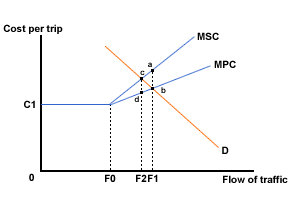The economic theory of traffic congestion
Figure 1 below shows how the analysis of externalities that we looked at in the previous section can be applied to the problems of traffic congestion.

Figure 1 Road transport, congestion and economic theory
Economic theory can be used to analyse the issues involved in traffic congestion as shown here. Figure 1 indicates the relationship between the cost of travel and the flow of traffic along a particular route. The essence of this theory is based on the fact that, when making a journey by car, a motorist only considers the marginal private cost (MPC). This is the cost directly attributable to him/herself, such as time, fuel and the maintenance of the vehicle, rather than the full cost of the journey, which may include costs imposed on society such as pollution, noise and time lost due to congestion. When added to the private costs, these are termed the marginal social costs (MSC), the difference between the two representing the externality imposed by the motorist.
 In outlining the theory, it is assumed that, when making a journey, congestion is the only externality. The graph represents the demand for travel along a particular stretch of road over a period of time. Up to a flow of traffic F0, there is no congestion, thus there is no divergence between MPC and MSC, although in reality, such a situation only applies to extremely low volumes of traffic.
In outlining the theory, it is assumed that, when making a journey, congestion is the only externality. The graph represents the demand for travel along a particular stretch of road over a period of time. Up to a flow of traffic F0, there is no congestion, thus there is no divergence between MPC and MSC, although in reality, such a situation only applies to extremely low volumes of traffic.
As the flow of traffic increases above F0, congestion is apparent and there is a divergence between MSC and MPC. Note that the MSC is equal to the MPC, plus the social cost of congestion.
If the demand for travel on this particular route is of the normal shape (represented by D on the graph) and is a measure of the marginal benefit, then the flow of traffic will be determined by the intersection of the demand curve and the MPC curve at F1 and the private cost to the motorist will be b. At a flow of F1, the external cost, not taken into account by the motorist, is ab (the difference between the MPC and MSC). This means that resources are not being allocated efficiently and that individuals are making more journeys than they would if they were aware of the full social costs.

To get some up to date examples on traffic congestion, try searching the Biz/ed In the News archive. You can do this in the window below.
Try searching on terms like:
- Congestion
- Traffic
- Externalities
